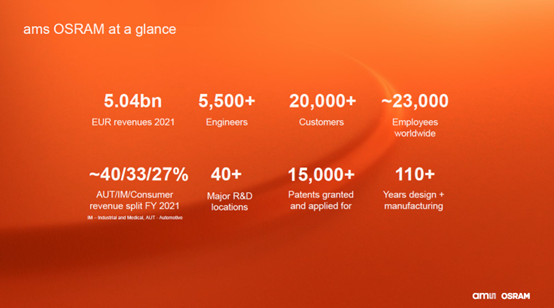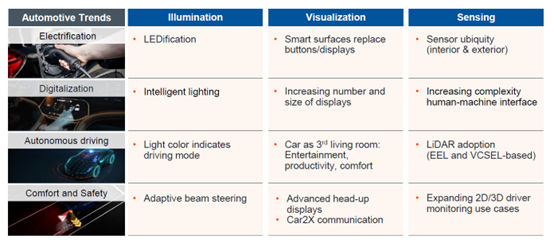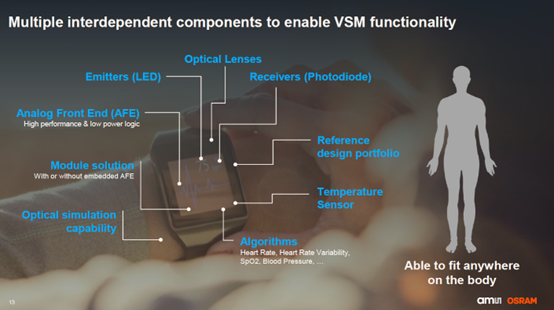As a global leader in optical solutions, ams OSRAM is known for great imagination and engineering expertise. Having over 100 years of combined history and experience, the company—by embracing the vision of Sensing is Life—continues to inspire creative thinking along with its customers and develop novel, stunning solutions.
In 2021, ams OSRAM generated EUR 5.04 billion in total revenue, mainly contributed by its business in the consumer, automotive, industrial and healthcare sectors. Specifically, the automotive/industrial/medical and consumer segments accounted for 73% and 27% of total earnings, respectively. The business distribution demonstrated the company’s balanced strategic development and resilience amid sharp slowdowns in economic growth throughout the year of 2022.
Additionally, ams OSRAM is one of the top three optical semiconductor businesses and is the only one in industry with a complete optical value chain, enabling itself to create unique value for clients.
In the long run, ams OSRAM has long valued Micro LED that has received wide attention in the market. While the size of Micro LEDs varies depending on their use for large, medium and small displays, the optical solution provider decided to focus on developing diodes for small displays, just like how OLED thrived in the small display market, and expects its products to be widely adopted within the next 2 years. ams OSRAM also offers eye tracking, 3D sensors and LED/RGB lasers for augmented/virtual reality (AR/VR) applications. As it introduces the Micro LED technology to these products in the coming years, ams OSRAM will continue meeting brands’ and consumers’ expectations.
Alan Chung, Country Manager in Taiwan
As Alan Chung indicated, ams OSRAM centers on the semiconductor industry and has been simultaneously developing its business in the industrial and healthcare sectors. Following ams’ acquisition of OSRAM, the company can now provide comprehensive optical solutions for customers, including those involving optical components, driver ICs, micro modules and algorithms.
In 2022, the automotive lighting, sensing, AR/VR segments have all made some progress. Automotive applications can be further divided into illumination, visualization and sensing. Specifically, sales of intelligent headlights, logo lamps / grille lamps and driver/occupant monitoring systems (DMS/OMS) have been impressive.
Regarding sensing applications, DMS/OMS achieves real-time monitoring of drivers to ensure driving safety thanks to the use of sensors, cameras, facial recognition, artificial intelligence, big data analytics and other software and hardware techniques. The system also helps avoid leaving children unattended in cars, making it an indispensable feature for advanced driver assistance systems (ADAS).
Overall, the illumination, visualization and sensing segments in automotive business enabled ams OSRAM to grow steadily amid the consumer gloom in 2022. With a comprehensive optical value chain, the company helps its customers create unique, novel and professional value.
Daniel Lee, CTO of ROA (Rest of Asia)
Daniel Lee mentioned about various leading technologies and solutions proposed by ams OSRAM. Following the acquisition of OSRAM, ams now offers comprehensive optical solutions for non-invasive biometrics to achieve vital signs monitoring (VSM), including those related to optical components, driver ICs, micro modules, and algorithms.
Moreover, the company has been focusing on developing ADB headlights with 12-100 LEDs each on matrix LED design. Equipped with LEDs that can be individually controlled, the headlights help extend the driver’s nighttime field of view (FoV) and the driver to react more quickly to any coming obstacles, hence better road lighting. ams OSRAM also has rolled out the EVIYOS 2.0 with largely increased 25,600 singly addressable LED pixels. The more the LED pixels, the more flexible adjustment of illuminated areas as well as better driving safety.
A smart cockpit can be seen as an all-in-one concept integrating various systems of information transmission, communication, entertainment and driver/occupancy monitoring. Car makers have also attempted to differentiate their smart cabins from those made by competitors with an effort to attract more users. Essential interfaces for human-computer interaction within such cabin—such as dashboards, rearview mirrors, head-up displays, center consoles as well as rear-seat entertainment applications—have thus more often been made using high-resolution and intelligent panels; they need to be safe, easy to use, practical and entertaining at the same time. In this regard, ams OSRAM offers backlight LEDs, drivers/controllers, optical sensors, ambient lights and many other products tailored as extensive solutions for smart vehicle cabins.
Author: Joanne / TrendForce


















